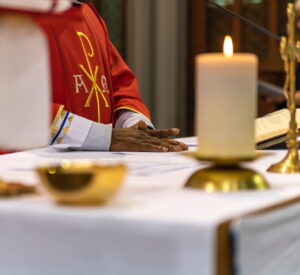
In 1952, educator Robert Havighurst wrote: “When the timing is right, the ability to learn a particular task will be possible. This is referred to as a ‘teachable moment.’ It is important to keep in mind that unless the time is right, learning will not occur” (Human Development and Education).
So how do you know when the time is right? One clear indication is when someone has a question. If I ask you how to get to the post office, that is the exact right time to teach me how to get there. If I ask you why the priest kisses the altar when he comes into church, that is the moment when you can teach me about reverence…or holiness…or sacrifice.
The Mass is filled with potential teachable moments like that. Pope Benedict XVI said, “The liturgy can be called the permanent catechesis of the Church, the inexhaustible source of catechesis.” Often, however, we miss opportunities to maximize the teaching potential of the Mass.
Liturgy is liturgy—not a tool for catechesis
The reason we miss opportunities may be because we misunderstand how the liturgy catechizes. The pope also said we must reject “all undue instrumentalization of the liturgy with ‘catechetical’ ends.” What that means is, we cannot turn the liturgy into a tool—an instrument—for catechesis. Liturgy is liturgy. It is not an excuse for a “teaching Mass” or a platform for things like a “three-minute catechesis” before the final blessing. When we “instrumentalize” the liturgy, we are attempting to teach people what we think they should know—not what they are asking to learn.
So if we are not supposed to instrumentalize the liturgy for “catechetical ends,” how does the liturgy teach? Think about falling in love. How did you learn about your beloved? How did she “teach” you what would win her heart? We woo and learn to woo mostly through symbolic behavior—like kissing. Why do you kiss your husband or wife when you wake up? Or before you leave for work? Or when you return home? For much the same reason the priest kisses the altar, I think. It is a sign of reverence…or holiness…or willingness to sacrifice.
If you want to teach your spouse that you love him, you show him signs like this. In the liturgy, if we want to catechize about the love of Christ, we do it through ritual signs and liturgical symbols. In much the same way that long-married spouses have a daily routine of such signs, the liturgy has a routine way of symbolizing the love of Christ.
Word
The first major symbol is word. The way in which “word” gets expressed is an orchestration of liturgical symbols.
- We gather to hear the word
- We process the word into the gathering
- We proclaim the word
- We sing praise to the word
- We might bow to the word
- We might incense the word
- The priest or deacon kisses the word
And most importantly, we respond to the word.
Eucharist
In the Mass, our response to the word is Eucharist—which is our second major symbol. Eucharist is a sacrifice of praise and thanksgiving. The way in which we offer that sacrifice is an orchestration of still more symbols.
- We present bread and cup for the sacrifice
- We sing holy praise with all the angels and saints
- We remember the story of our salvation—especially the story of Jesus’ death and resurrection
- We break the bread that has become body
- We pour out the cup, now filled with the blood of new promise
- We share in the feast of sacrifice
- We pray as one that the sacrifice we have just shared will save the entire cosmos
How the Mass teaches
The way the Mass teaches best is when we do these actions as clearly and simply and elegantly as possible. When we rush or minimize these potential teachable moments, we reduce the likelihood that a question will arise in the hearts of the newcomers.
On the other hand, when we take care to do these symbols well—with a sense of reverence, and holiness, and sacrifice—they teach in a way that no other action of the church can teach.












Nick, this is very helpful. I understand the desire to do teaching masses however the ones I’ve sat through turn out to be very tedious. I agree that doing the symbols well (and robustly) as we celebrate the liturgy is the best way to teach the liturgy.
Thanks Joe! I think there is a little spike in “teaching Masses” these days because of the new translation of the missal. But my experience is like yours–tedium. Liturgy should always be fascinating. As should catechesis! Thanks for all your contributions to the fascination.
This is a great article, Nick! Sometimes we teach out of our own need to tell someone something that WE think is important. That may not necessarily be so important to the person we are addressing. I personally find “teaching Masses” filled with facts, terminology, and statements that few people follow. It is much better to preach using example and story than with facts and figures that we can’t recall or pray with during the week. Thanks!
Hi Pam. You are so right! Thanks for sharing your thoughts on this.
Dear Nick,
This was great! I am beseiged by folks who think i should “do” a “teaching” Mass for those in RCIA or for the children, or ….! There is a retired priest from here who would add about 15 minutes on to each mass as he “sermonized” about the Mass before each major part of the liturgy and then he’d wrap it up at the end – drove people nuts! While every liturgy is catechetical, the liturgy is not catechesis! I don’t like “evaluating” liturgies either!
Thanks Leota! I’m really grateful for all your support and all the fine work you do.
Correct. Liturgy is worship Teaching about the Mass can and should be done in the classroom.